
March 3, 2006
Gallitzendörfer has provided information here in ample volume for future reference in similar cases. This article has been put here in response to a website visitor's question concerning a note about Gallitzendörfer in a website. (a local copy is here)
There, a person called "G.Müller" affirmed that Gallitzendörfer has exposed musical instruments for years which never did produce any sound and never were sold to anybody.
To understand this, it has to be explained how Gallitzendörfer participated on the Musikmesse Frankfurt. Gallitzendörfer had unpleasant experiences before, with the introduction of his first prototype to various companies (where the best offer (from a Japanese manufacturer) was about 50 000$, not even sufficient to finance a single international patent-). But read this letter: "Sequential Circuits Inc." - seriously - wanted Gallitzendörfer to send his prototype (a still existing synthesizer with interpolation controlled by a joystick) to them, together with an instruction manual ! (with other words: an instruction how to copy this prototype without effort - Gallitzendörfer could not believe this at the first moment...).

| The incredible letter fom "Sequential Circuits" |
So, Gallitzendörfer decided to bypass the - at least in Germany - established corrupt system which worked (and works ?) like the following:
The musical instrument producing company pays the local "smearer press" some considerable amount for advertising, starting with 20 000 $ (according to inofficial information, retrieved later on at the Musikmesse Frankfurt from some product managers; the upper limit is open).
The "smearer press" prints "friendly" test reports about the company's products, neglecting or not even mentioning the possible more innovative companies which are not willing/able to join in this game.
The distributors take these "reports" from the "smearer press" as a source of reference arguments to convince the uninformed end customers, thus closing the circle.
Gallitzendörfer, as a highly independent, innovative and creative person, definitely was not interested in corruption, nor seemed this to be necessary for him. During the presence from 1987 until 1997 at the Musikmesse Frankfurt (Germany), he presented not less than six completely new generations of DSP systems, partially even with migration to different manufacturers and basis technologies (i.e. not only an upgrade of one and the same system over the years). This was necessary because Gallitzendörfer intended to realize a product vision on a long term basis with these high processing requirements.
This certainly was not desired by some self-complacent "local technical gurus", ensnared by the local "smearer press", always ready to hype the ones dancing to their tune. In Gallitzendörfer's case, they acted like some of the lesser intelligent bird races which tend to stick their heads into the sand as soon they are realizing a much stronger, if not incomparable, opponent.
In fact, they declared for themselves, and their breed, Gallitzendörfer simply as non existent, although he made performances with his own-developed instruments for some years at the huge Musikmesse "Galleria" stage where thousands of visitors (occasional or with dedicated interest) had the chance to listen to the sounds of his musical instruments, played by himself.
The company where this "G.Müller" was involved was not even able to develop reasonable digital filters. So they made their dull customers believe that the "analog sound" of their "Micro Shit" synthesizer's primitive analog filters are so much better. They some day showed up at Gallitzendörfer's booth in 1993, involving him in a conversation about digital filters. Gallitzendörfer, however, was (once again) "smart enough" not to tell them exactly how he had developed his digital filters four years ago, allowing the user to choose between "Bessel", "Tchebychev" or "Butterworth" analog simulation characteristics, for example. (Gallitzendörfer did not mention at this "conversation" that already idiot's software for calculating the coefficients of digital filters was existing at that time - at least they would have had to know what "coefficients" are and how to use them...)
In fact, their primitive synthesizer's technology resembled the technology which Gallitzendörfer used and presented eight years before, in 1985 (already there ignored by the local "smearers"), together with Ensoniq's first product: a sampling synthesizer with analog filters at the outputs. (1985 was a "test shot" for Gallitzendörfer's presence at the Musikmesse Frankfurt with a very primitive open booth. This led to a large loss of demonstration material mounted at the booth's walls, including the theft of Gallitzendörfer's Logo name plate at the end of the event. (-did you think this from Germany ??) This was the reason why Gallitzendörfer decided for the future to have only completely closed, lockable booths in the following "real" presentations starting at 1987.)
Already there, however, a slight difference between Gallitzendörfer's and Ensoniq's technology existed. While Ensoniq used a tiny RAM memory of 64 kBytes (similar to Korg's playback "Workstation" M1" two years later in 1987) of about two seconds of playback time and filters from analog synthesizers (similar to "Micro Shit"), Gallitzendörfer used already 1 Megabytes x 12 Bits of recent dynamic memory technology, combined with expensive digital controllable Military Grade filters from sonar applications with a 10th order magnitude. (Let the idiot above calculate what actual rolloff in dB they had...)
Already at this point it was evident that a weak but inexpensive technique (about 4,500 $) was definitely more successful for the masses than a high-quality but less affordable technology (about 15 to 30 000 $ at that time). So, Gallitzendörfer's intention was for the following years to reduce the costs while retaining the high "musical" quality.
But there was another point: Gallitzendörfer's unique invention of "Matrix Memory", later "Matrix Interpolation". Again, the smearer idiots confused this with a primitive existing "Midi Matrix" which has nothing common to actually calculate the sounds from bottom up, allowing only a simple blending of tones.
This technology needs much more processing power than a simple playback of samples which is dominating the synthesizer technology until today (-with more memory, at least-). A task Gallitzendörfer is involved until today - but there are additional ingenious unpublished ideas.
But now to the evidences compromising the malicious breed of above:
The founders (CEOs) and / or leading developers of the following companies had the occasion to listen to Gallitzendörfer's products at his booth at the Musikmesse Frankfurt from 1987 until 1997 - partially by playing themselves on Gallitzendörfer's instruments (sequence is in alphabetical order) - you may ask them if you have the occasion to:
Dynacord
F.A.T.A.R.
Hohner
Kurzweil
North Lead
O.R.L.A.
SEKD
Steinberg
UHT
Wersi
This does not include the uncounted number of visitors which were Gallitzendörfer's main targets (in most cases accurately recorded by their addresses). They are responsible that Gallitzendörfer decided not to go into a series manufacturing of his products at this time; he would have had earned considerably less than a higly-qualified engineer he was (and is !), hand-building a small series for the enthusiasts, highly time-involved with their special individual (one-piece-development) requests, questions and monthly change requests...
It can be seen from the above list that none of the leading Japanese Companies officially visited Gallitzendörfer's booth. They were, more discretely, interested listeners to Gallitzendörfer's performances at the huge "Galleria" stage at the Musikmesse Frankfurt. This stage is placed at a prominent position integrated between two halls, with a mixture of seat rows for approx. 500 listeners, and smaller booths between the halls, attracting by this way dedicated concert visitors and occasional visitors at the same time.
Gallitzendörfer performed live (with sequencer support) from 1994 until 1996 at the "Galleria" stage, demonstrating by this way different generations of his keyboard instruments. The following letters serve as an evidence of correspondence between Gallitzendörfer and the responsible organization personnel for these annual performance events (30 minutes in duration). These persons were present at least at Gallitzendörfer's sound checks. Gallitzendörfer has included the letters of two years' performances, 1995 and 1996:
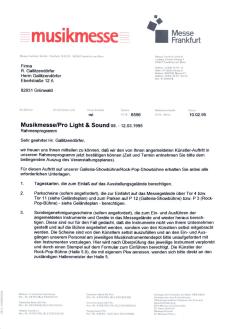 |
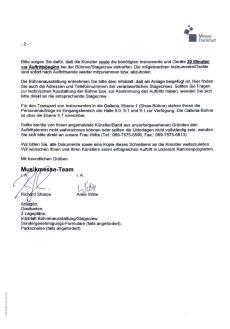 |
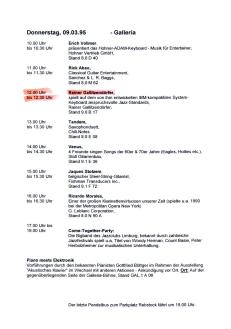 |
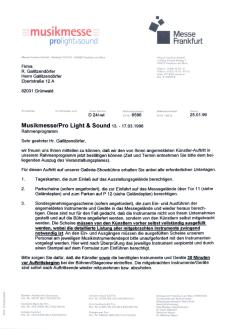 |
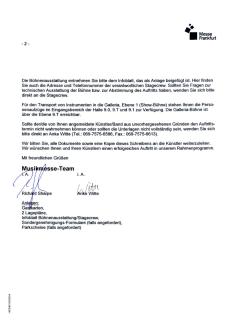 |
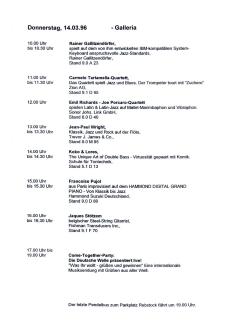 |
While we are into the theme - next will be included the sequence of unique world premieres of innovations Gallitzendörfer presented at the years of presence at the Musikmesse Frankfurt. You can be sure: Most of these informations were suppressed by the corrupt "messaging system" described above - otherwise quite some of you readers would have known this already. During his presence at the Musikmesse Frankfurt from 1987 until 1997, Gallitzendörfer presented the following innovations:
1987: The world's first musical keyboard instrument with a high resolution graphic display (LCD 640x400 pixels, b/w)
1988: The world's first musical keyboard instrument with IBM (or "PC") compatible hardware, running under the own operating system "GR-OS" (not "MS-DOS")
1989: The world's first musical keyboard instrument with the Microsoft Windows(R) Operating System, displayed on a hi-res color LCD
1990: The world's first musical keyboard instrument with a hi-res touch screen - a little while before the "PDAs"
1997: The world's first musical keyboard instrument with a Digital Processing power of over 1 Giga Operations per Second
In 1997, Gallitzendörfer had the occasion as one of five European companies (among them were Siemens, SGS-Thomson - and the "One Man Corporation" Gallitzendörfer, naturally) to get one of the first alpha-version chips of a new DSP generation. This revolutionary breakthrough encouraged Gallitzendörfer to continue his developments with the target of still more compacting his tone generating system.
What occurred between 1990 and 1997 ? Most of the time, a strong annual migration stepping over six DSP hardware generations - not revolutionary for the public, but impressive for the developer. And a considerable size reduction, being one of the strong feedback influences of the Musikmesse visitors.
What about selling Gallitzendörfer's products ?
At least the people involved in prototype manufacturing know that a single piece of a case or a printed circuit board costs about the same as three pieces of the same kind. So did Gallitzendörfer: in most cases, he had let produced three instead of one of these prototypes (the assembly had to be done in hand work). Two of them (-Gallitzendörfer has saved a specimen of every prototype for himself-) were then sold to especially trusted persons, some of them bought more than one of Gallitzendörfer's generation products. Maybe a good collector's investment for the future...
On a more serial basis, parts of Gallitzendörfer's products were sold as OEM manufacturer's products to other companies - this can already be seen on some older news articles of this web page. For example, the "G100" boards have been sold in quite a number of pieces to more than one company. Not to mention the DSP boards - most of them have been sold as components and/or complete developments to companies in the field of Military, Communications, Imaging, and Medicine markets. Not rarely, the sequence had been reversed: First came the requirement (or project offer) from one of the companies, later on Gallitzendörfer had the chance to use these developments for his own musical instrument projects in a kind of a second utilization. And this situation lasts until today...
Why did Gallitzendörfer stop his annual presence at the Musikmesse Frankfurt ?
Very simple - the media world had changed considerably, or, more exactly, was about to change. The real changes occurred two years later, but Gallitzendörfer knew about these changes more early (not for the first time). With these new changes (which ? - the answer is up to the reader), there simply is no more need to cope with stupid, arrogant "commercial smearers" and their associated evil, evil financier companies on a public exhibition ! They all simply are no more needed for a one-man-corporation like Gallitzendörfer's. The great possibilities of today are perfectly matched to small, flexible initiatives which do not need a large advertisement apparatus and do not have to sell large quantities of products.
| |
(c)Copyright 1997-2017 Gallitzendörfer. All rights reserved. |